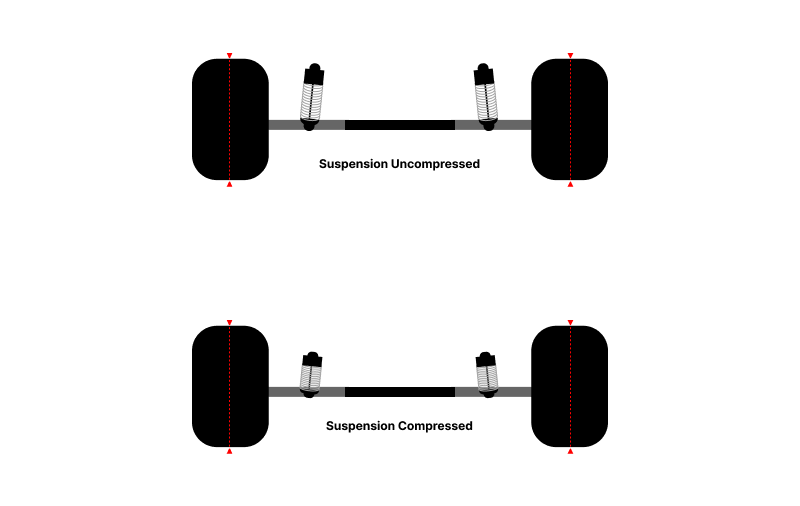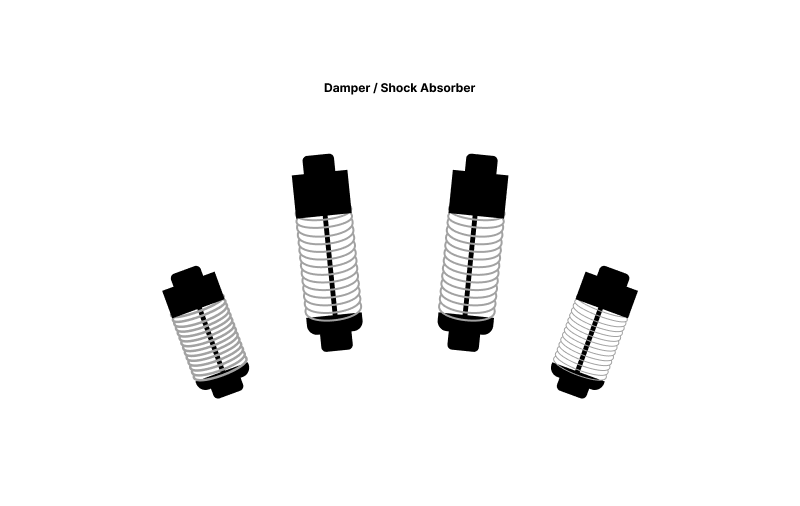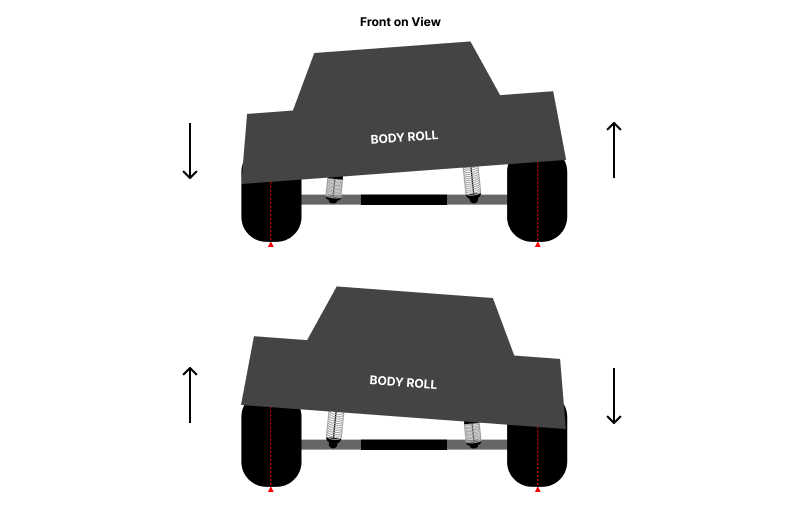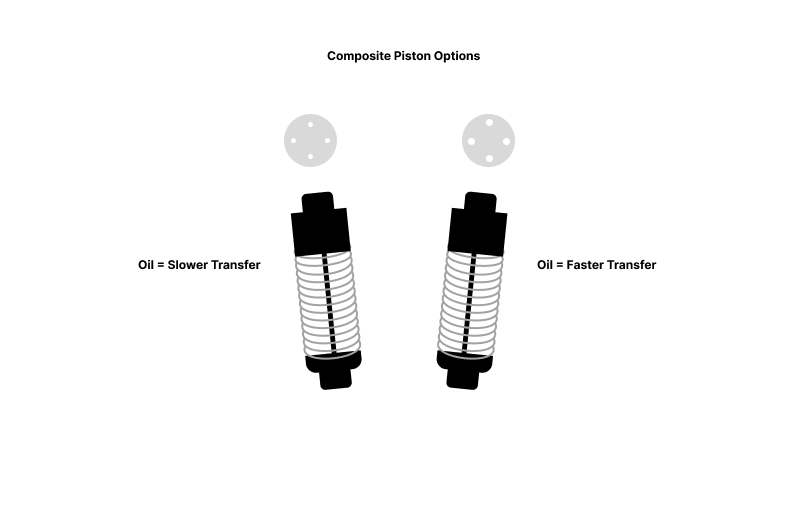Shock Absorber, Coil Spring, Oil,
Almost sounds like an old mattress.
But you didn't come here to get a good nights rest, today we're diving into your suspension setup.
One of the most crucial aspects of a well-performing RC drift car is it's handling.
Properly tuned suspension can be the difference between a smooth, controlled drift and a frustrating off road excursion towards pit-lane.
Understanding the Basics:

RC drift car suspension, much like a full sized drift car, is designed to keep the tires in contact with the ground, absorbing bumps and allowing for controlled weight transfer.
In drifting, weight transfer is key. You want the car to shift its weight predictably, allowing you to initiate and maintain a drift.
Two of the main suspension components that affect weight transfer the greatest are:
Springs
These coil-shaped components control the rate at which the suspension compresses and extends. Stiffer springs resist weight transfer, leading to a more responsive feel but potentially less grip on uneven surfaces. Softer springs allow for more weight transfer, which can be good for initiating drifts but can also make the car feel less stable.
Dampers / Shock Absorbers
These work in conjunction with the springs to dampen oscillations. They prevent the car from bouncing excessively after hitting a bump and help it settle quickly. Dampers control how quickly the weight transfers. Too little damping and the car will feel bouncy and unpredictable. Too much damping and it will feel sluggish.
Below displays different spring rates (thicknesses) attached to shock absorbers (dampers)

How Suspension Affects Handling:
Acceleration: During acceleration, the rear of the car tends to squat down. The rear suspension needs to be tuned to handle this weight transfer. Too much squat can lead to loss of traction, while too little can make the car feel unstable.
Braking: When braking, the weight shifts to the front of the car. The front suspension needs to absorb this weight transfer to prevent the car from nose-diving and losing control. Properly tuned front suspension improves braking stability.
Drifting: During a drift, the weight of the car is constantly shifting. The suspension needs to allow for this weight transfer while maintaining grip. This is where the balance between springs, dampers, alignment (camber, and caster) becomes critical. You want the car to be predictable and controllable throughout the drift.
Body Roll:
Body roll is the leaning of the car to one side during cornering or drifting. It's a direct result of weight transfer. Some body roll is desirable as it allows the car to communicate its limits to the driver. However, excessive body roll can lead to instability and loss of control. Stiffer springs help reduce body roll. Easy right?

Shock Oil:
Key considerations for RC drift shock oil include viscosity, typically measured in weight (wt) or centistokes (cSt). Lower viscosity oils allow for quicker weight transfer, which can be beneficial for initiating and maintaining drifts. Conversely, higher viscosity oils provide more damping, resulting in a slower, more controlled weight shift.
Many RC drift enthusiasts experiment with different oil viscosities in the front and rear shocks to achieve the desired balance of grip and slide. Additionally, factors like piston hole size and spring stiffness interact with the shock oil's viscosity, further influencing the car's handling characteristics.
Each company has their own testing standards, so some wt/cst may feel different when using Company A or Company B shock oils. So it's really about testing out yourself and picking what feels good for you.
Shock oil weight (wt) or centistokes (cSt) comparison table is below to help with any confusion of oil labelling:
| Weight (wt) | Centistokes (cSt) |
|---|
| 10 wt | 100 cSt |
| 15 wt | 150 cSt |
| 20 wt | 200 cSt |
| 25 wt | 275 cSt |
| 30 wt | 350 cSt |
| 35 wt | 425 cSt |
| 40 wt | 500 cSt |
| 45 wt | 575 cSt |
| 50 wt | 650 cSt |
| 55 wt | 725 cSt |
| 60 wt | 800 cSt |
| 70 wt | 900 cSt |
| 80 wt | 1000 cSt |
Piston Composites:
Piston Function:
- Inside an RC shock absorber, the piston is a component that moves up and down within the oil-filled cylinder.
- This piston has holes through which the oil must pass, and the size and number of these holes significantly impact the shock's damping characteristics.
Hole Influence:
The size and number of holes directly affect the rate at which oil flows through the piston.
More or larger holes allow oil to flow more freely, resulting in less damping. This translates to quicker suspension movement.
Conversely, fewer or smaller holes restrict oil flow, increasing damping and slowing down suspension movement.
Composite Effects:
Therefore, the "composite" effect comes from the combination of:
These factors work together to determine how the shock responds to impacts and weight shifts.
Drifting Specifics:
In RC drifting, precise control of weight transfer is crucial.
Therefore, drift enthusiasts often experiment with different piston hole configurations to achieve the desired balance of responsiveness and stability.
For example, some might use pistons with larger holes for quicker weight transfer during drift initiation, while others might prefer smaller holes for more controlled slides.

Tuning Tips for Beginners:
Start with the basics: Don't try to change everything at once. Start by understanding the function of each component and make small adjustments.
Test and adjust: The best way to find the perfect setup is to test your car on the track and make adjustments based on its behaviour.
Keep a record: Keep track of your setup changes so you can easily revert back if needed.
Seek advice: Don't be afraid to ask for advice from experienced RC drifters or better yet, ask us here on the forums. We can offer valuable insights and help you fine-tune your setup.
Adjustments and Their Effects:
Stiffer Rear Springs: Reduces rear squat under acceleration, improves responsiveness, but can reduce rear grip on different track surfaces.
Softer Front Springs: Increases front grip during braking and drift initiation, but can make the car feel less stable at faster speeds.
Piston Composites: More holes at a larger size increase the amount of oil transferred through the piston, less holes and a smaller size decrease the amount of oil transferred.
Tuning your RC drift car's suspension is an ongoing process. It takes time and experimentation to find the perfect setup for your driving style and track conditions.
Don't be discouraged if you don't get it right away. Keep learning, keep practising, and you'll be drifting like a pro in no time!
If you have any questions, don't forget to ask 🔰 we're here for all drifters.